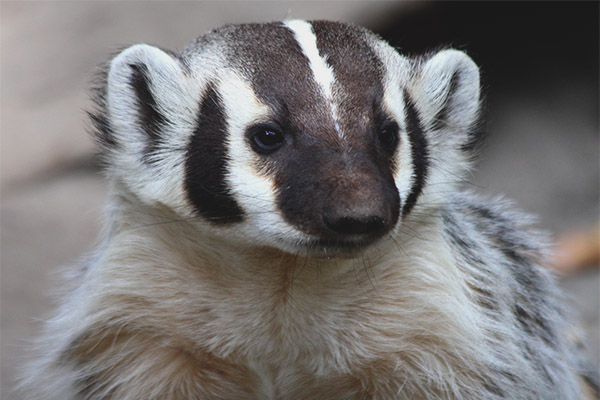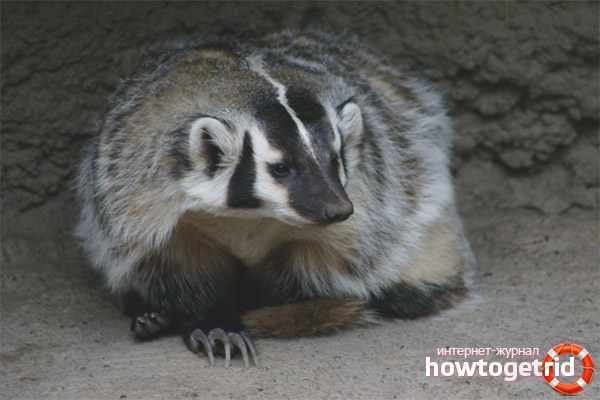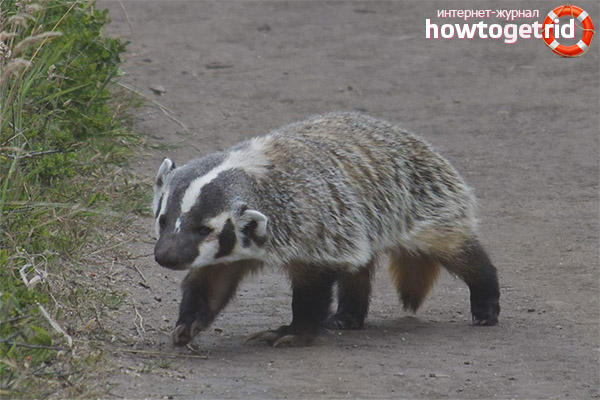The content of the article
In a fairly large space, ranging from Canada and ending with the territory of Mexico, often comes across a fellow of the native badger, which in these places is called the American badger. This type appeared a long time ago, almost six million years ago. Of course, the animal is not a close relative of its Russian brother, but rather a distant one, due to its belonging to another genus. But still they are very similar to each other, only the American is inferior to the ordinary badger with its small dimensions. The size of the length of the body directly of an adult individual ranges from 44 to 74 cm, plus the tail - from 10 to 16 cm.
Representatives of the family Kunih, living in the wild, reach a weight of 12 kg, and in captivity - 18 kg.Powerful front paws with long claws allow the animal to actively dig the ground without bothering itself.
Value and color of fur
The coat is very long and hard. Once the aborigines were very revered badger fur, used it as one of the elements of national attire. Used in everyday life, as a brush for paint work and shaving brush. Currently in the United States, the American badger is listed as a protected animal.
The appearance of the badger is pretty cute, the skin below the black shade, and on the top and sides of the gray or reddish, there may be some black ripples. In the center of the head and along the entire length of the back, starting from the nose and ending at the base of the tail, there passes a narrow white stripe. Muzzle animal spotted color.
Life process
Favorite food
Food preferences are given to small rodents, chicks, insects and worms. In rare cases, can arrange a snack carrion. Snakes are a kind of delicacy. In the autumn, the appetite increases several times, badgers try to create fatty deposits before hibernation begins. Due to these subcutaneous deposits can live all winter.
They lead an active lifestyle at night, they like to spend the day in a dream. In deserted areas and in sunny weather, badgers can leave their shelter even in the daytime.
Mating and reaching puberty
The mating game in this species occurs in August and lasts only one month, but the fertilized egg does not survive for a long time, it joins the uterus only a few months later, although the gestation period itself is six weeks. The duration of the complete gestation process, from mating and conception to birth, comes to 8 months.
The birth of children in April, the end of the process of childbearing begins in July. The number of calves in one litter reaches 5 individuals, but most often two or three restless children are born. The babies are blind, but immediately covered with a thin layer of smooth fur. Barsuchat is fed with milk for seven weeks, only then it may be eaten with solid food.
Female puberty occurs much earlier than in males. The female is ready for marriage at four months old, and the male matures only by the year.
A little about family ties
As already noted, in a distant relationship with the American counterpart are species inhabiting the territory of Russia and European countries. This ferret and the usual badger.The main difference between the ferret type and its relatives from the family of Mustelids is the color of the coat of the back. This species contains five varieties.
An ordinary badger differs from other individuals of the family in its size and weight. He is bigger and heavier. Such species settle not one by one, but entire colonies, uniting their burrows among themselves into the whole city. In contrast to American relatives, it is a predatory animal. Lives in mixed and taiga forests, which are very many in Russia. Therefore, the majority of this family settled in our country. As well as his fellow counterparts, he prefers active activities at night.
The reality of our day
There are cases that badgers inhabiting the territory of European countries,are the cause of tuberculosis in livestock, they tolerate it. The American species is an exception, does not infect other animals.
The life of the badgers in the wild is small, only 5 years. But in zoological parks they prolong life to almost 20 years. Proper care and good nutrition are the guarantee of longevity of the American badger.
Video: American Badger (Taxidea taxus)













To send